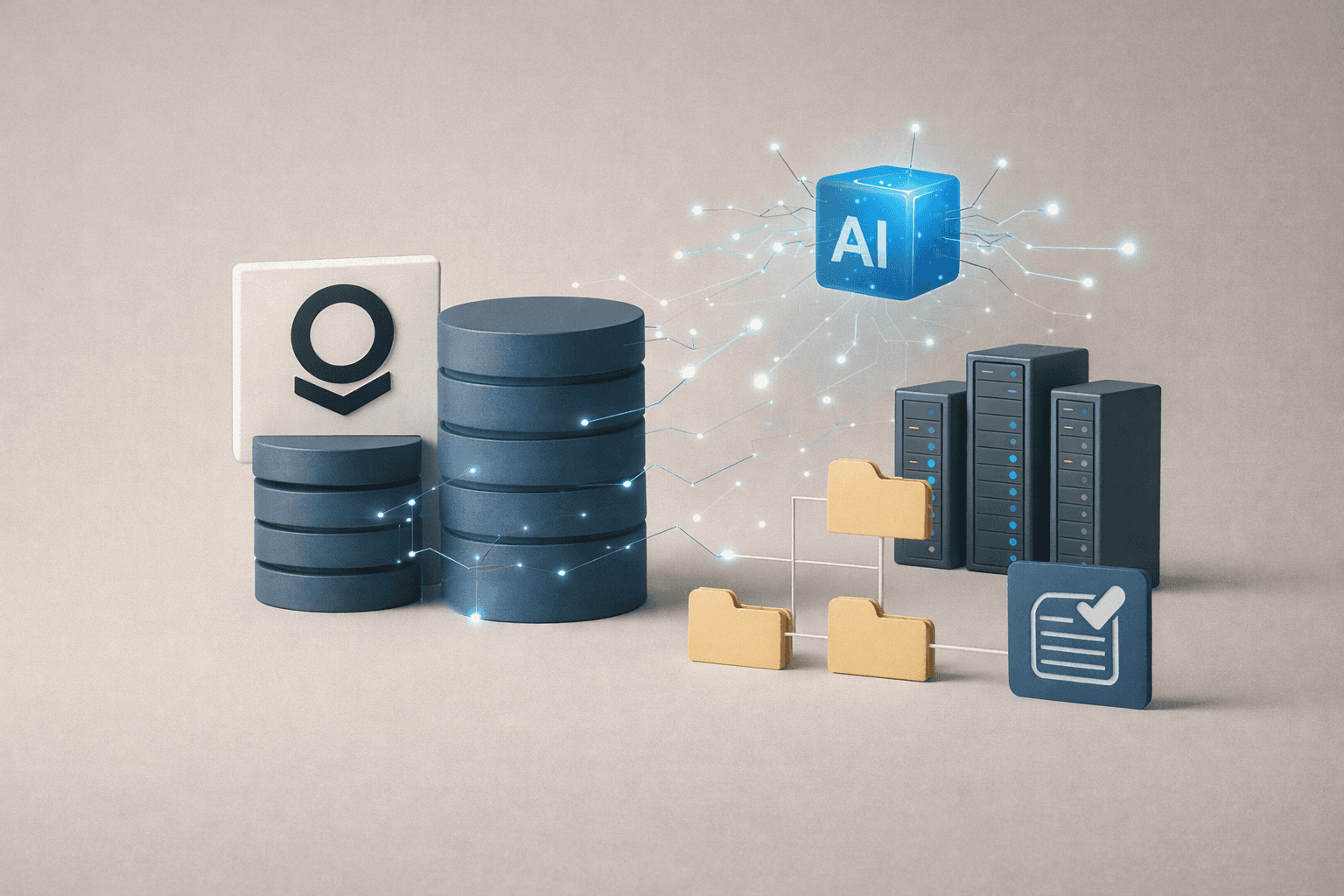Insight
AI for Financial Data Analysis: Transforming Massive Financial Data into Insights
Nov 10, 2025
Why Is AI Essential in Financial Data Analysis?
Explosive Growth of Structured and Unstructured Data
With accelerating digital transformation and the sophistication of financial services, the volume of financial data handled by organizations is skyrocketing. Not only traditional structured data like financial statements, income statements, and balance sheets, but also unstructured documents such as emails, contracts, investment proposals, meeting notes, messenger chats, countless PDFs, image files, disclosure documents, market news, and product brochures are all now targets for analysis. There is a mix of formats and structures dictated by various domestic and international regulations and accounting standards, natural language text, scanned images, Excel tables, and complex formulas. It is virtually impossible for humans to read and interpret all this information one by one. Furthermore, this data is generated in real time and dispersed across numerous internal and external systems, so from data integration and cleansing to search and analysis, innovative automation is required throughout the entire process.
The Limitations of Manual Analysis and Delayed Decision-Making
Traditionally, most finance, accounting, investment screening, and risk management teams have depended on labor-intensive processes: manually reviewing various financial documents, performance reports, contracts, and disclosures; copying tables into Excel; and repeatedly comparing numbers and texts by hand. This approach, reliant on manual labor, is prone to frequent errors, data omissions, and delays in updating or misinterpretation—directly causing real-world delays in decision-making. Especially in time-sensitive tasks such as deal sourcing, M&A, investment due diligence, portfolio rebalancing, and audits, the need for automated analysis and AI-driven insight extraction is growing dramatically.
Securing Competitiveness with Real-Time Insights
In the fiercely competitive global financial market, securing timely insights is the core of seizing business opportunities and managing risk. AI can detect subtle patterns, anomalies, and new risk factors in massive data streams in real time and use predictive models to quickly simulate future scenarios. Beyond just organizing and summarizing data, AI now powers automated real-time analysis for summary reports, KPI dashboards, risk alerts, industry trend analysis, and customized investment or business strategy, enabling companies to seize new business opportunities and optimize risk management.
Key Roles of AI in Financial Analysis
Automated Financial Statement Analysis and Risk Pattern Detection
AI automatically collects and organizes hundreds to thousands of financial statements, quickly exploring anomalies (outlier detection), debt structures, and liquidity and key risk patterns in income statements, balance sheets, cash flow statements, and more. It provides visualizations that highlight key differences between peer companies, year-on-year and quarterly trends, and both seasonal and abnormal fluctuations. Automated comparative analysis by AI greatly enhances productivity and accuracy in investment screening, due diligence, and auditing tasks.
Performance Trend Summarization and Benchmarking of Target Companies
AI’s summarization and benchmarking capabilities automatically analyze three to five years of historical performance, growth, profitability, and cost structure for target investment companies, and compare these to competitors and industry averages. Key change points—such as changes in sales, profitability, main business lines, and R&D trends—are highlighted. AI-generated draft screening and investment feasibility analysis enables practitioners to focus on advanced interpretation and strategy.
Market News and Disclosure Data-Based Situation Summaries and Impact Analysis
AI collects and summarizes a massive array of external data in real time—such as DART disclosures, broker reports, industry news, policy announcements, and even SNS. Through text mining and sentiment analysis, AI automatically analyzes the impact of specific events (interest rate hikes, regulatory changes, policy announcements, etc.) on industries or companies. Beyond mere news clipping, AI provides key issues, expected impacts, and scenario-based responses, empowering practitioners to make informed, rapid decisions.
Portfolio Optimization and Risk Scenario Simulation
AI analyzes diverse asset classes (stocks, bonds, alternative investments, etc.) within portfolios, as well as each company’s financial indicators and external factors (interest rates, FX rates, commodity prices), to suggest optimal portfolio structures. With machine learning-based scenario simulations, AI can predict changes in profit and value in real time in the event of risks like recessions, interest rate surges, FX volatility, or regulatory tightening, and even automatically recommend risk mitigation strategies. The entire process of asset allocation, risk management, and investment strategy is being revolutionized by AI.
Key Technical Components
Document Summarization and Q&A (RAG-Based Analytical Interface)
State-of-the-art AI for financial data analysis employs Retrieval-Augmented Generation (RAG) and natural language search interfaces to quickly and accurately answer user questions (e.g., "What was this company's 2023 operating profit?" or "What caused the sudden jump in debt ratio?") using evidence directly highlighted in the original document. AI can summarize and answer based on original sources, presenting highlighted text, charts, and tables to boost trust and transparency.
Natural Language Processing-Based Performance Summaries and Risk Sentence Extraction
AI semantically extracts and summarizes KPIs, performance metrics, risk factors, and notes from multilingual financial documents (Korean, English, etc.). Event detection, issue-driven summarization, topic highlights, and risk signal detection are enabled by advanced NLP and text mining, so that only core content from massive document sets is quickly surfaced.
Financial Indicator Prediction Models and Time Series Data Analysis
With deep learning and machine learning models, AI can accurately forecast the future trends and variations of key indicators—revenue, operating profit, debt ratio, cash flow, and more. Outlier detection, future risk simulation, and trend analysis are supported in real time, reflecting not only seasonal and cyclical patterns but also external factors such as policies and exchange rates.
Vector Search-Based Peer Comparison and Similar Case Exploration
Using embedding and vector search, AI can semantically explore vast domestic and overseas peer and case databases, rapidly benchmarking similar companies with matching growth curves, risks, or accounting events. Beyond simple numerical comparison, benchmarking reflects not just numbers but context and meaning, enabling higher-order competitive analysis.
How Wissly’s AI for Financial Data Analysis Stands Out
Optimization for Korean Financial Statements, Audit Reports, and Disclosure Documents
Wissly’s NLP and analytical engines are tailored for Korean-language financial statements, K-IFRS-based audit reports, DART filings, and quarterly reports, supporting various local document formats and terminology systems. Even unstructured documents such as PDFs and scanned images are precisely digitized via OCR and layout analysis, enabling perfect recognition of tables, charts, notes, and mixed-content structures. The system flexibly supports diverse financial forms required by on-the-ground practitioners.
On-Premises Structure: Secure Internal Analytics with No Data Leakage
Wissly supports an on-premises architecture so that all data is managed and analyzed only within the internal network, with no external data leakage. Even in organizations with strict security and regulatory requirements—finance, law, public sector, large enterprises—Wissly can be confidently deployed, and cloud/hybrid options are also available.
Enhanced Accuracy with Source Highlighting, Summaries, and Integrated Q&A
All analysis results in Wissly are presented with source highlighting, evidence-based summaries, and integrated Q&A, maximizing reliability and verifiability for evidence-driven tasks like audits, investment reviews, and regulatory reporting. Exporting results as PDFs and sharing highlights is also supported.
Real-Time Document Indexing via Accounting System and ERP Integration
Wissly integrates with in-house ERPs, accounting systems, DART, and external databases, so that new documents and data are indexed and reflected in analysis immediately. This ensures up-to-date reporting, seamlessly connecting with operational processes.
Built-In Logging and Governance for Audit and Review
All queries, analysis histories, access records, and result viewing logs are automatically stored, enabling integrated management of real-time audits, history tracking, compliance, and internal control. Fine-grained permissions, user audit logs, and workflow management are built in, supporting robust data governance.
Practical Use Cases
Investment Screening: Automated Summary of Company Performance and Disclosures in Deal Sourcing
In the deal sourcing and screening stage, Wissly AI automatically summarizes and analyzes DART disclosures, financial statements, and market news, generating company profiles. Key financial indicators, peer comparisons, recent issues and risks, and growth potential are all provided via dashboard, dramatically improving analysts’ efficiency.
Financial Planning: Automated Cost Structure Summaries and Improvement Suggestions
Financial planning teams receive automated summaries of each division’s profit/loss structure, expense execution, and efficiency metrics, with benchmarking and outlier analysis supporting quick identification of areas for cost improvement and structural innovation. The time spent on repetitive report writing and data compilation is greatly reduced.
Risk Management: Potential Risk Highlighting and Q&A-Driven Analysis
Risk management teams use AI to automatically highlight potential risks in disclosures, reports, and contracts, and instantly conduct in-depth analysis through Q&A interfaces (e.g., "What are this company’s risk triggers?"). Regulatory risks, legal risks, and financial vulnerabilities can be explored contextually.
CFO Team: Automated Drafting of Monthly Performance Reports and KPI Summaries
CFO teams use Wissly AI to automatically draft hundreds of monthly performance reports, with summarized KPIs, key figures, and issues immediately available for management and board presentations. Flexible support for multiple report formats and custom dashboards is also available.
Additional Uses: Internal Audits, Regulatory Reporting, Employee Training, and More
Internal audit teams automatically extract regulatory issues and internal control deficiencies from massive financial materials; training teams automate financial information summarization and Q&A in training materials and manuals, supporting onboarding and knowledge transfer. Automated regulatory reporting, policy change monitoring, and investor presentation generation can all be powered by AI, supporting a wide range of departments.
Considerations for Adoption
Ensuring Reliability of AI Analysis (Source, Accuracy, Verification Loop)
To guarantee the reliability and accuracy of AI analysis results, multilayered verification systems must be implemented: document source links, highlights, user feedback and verification loops, and approval by responsible decision-makers. Transparent evidence presentation and user trust are essential.
Strategies for Handling Diverse Financial Documents and Mixed Formats (Tables, Figures, Text)
To process various formats (HWP, PDF, Excel, images, etc.) and complex mixed structures of tables, numbers, and text, multimodal AI and robust data cleansing/structuring strategies are required.
Integration with Existing Systems (ERP, DART, K-IFRS, etc.)
Organizations must thoroughly check compatibility and extensibility with their existing ERP, accounting systems, DART, and K-IFRS infrastructure: API compatibility, real-time data reflection, and integration workflows are crucial for success.
Security and Privacy Protection for Regulated Industries
Finance, legal, and other regulated industries must prioritize personal data, internal information, and trade secret protection. Policies for data encryption, fine-grained access control, internal network operation, audit logs, and AI-driven security should be established in advance. Compliance with regulations and international security certifications (ISO, ISMS, etc.) should be verified.
Organizational Culture and Change Management
Adopting AI-powered analysis is not just a technical revolution but a shift in operational processes and organizational culture. User education, pilot projects, gradual rollout strategies, and feedback-based improvement are needed for successful adoption and continuous improvement.
Conclusion: Moving from Number-Centric to Insight-Centric Decision Making
In this era where AI automatically analyzes and summarizes financial data, companies can handle complex, massive data with reliability, extracting key insights and evidence rapidly to support strategic decisions for management, investors, and practitioners alike. Move beyond simple numeric reporting: experience a new paradigm of financial data analysis that realizes data-driven competitiveness and innovation with Wissly—where trust and efficiency go hand in hand.
Recommended Content










